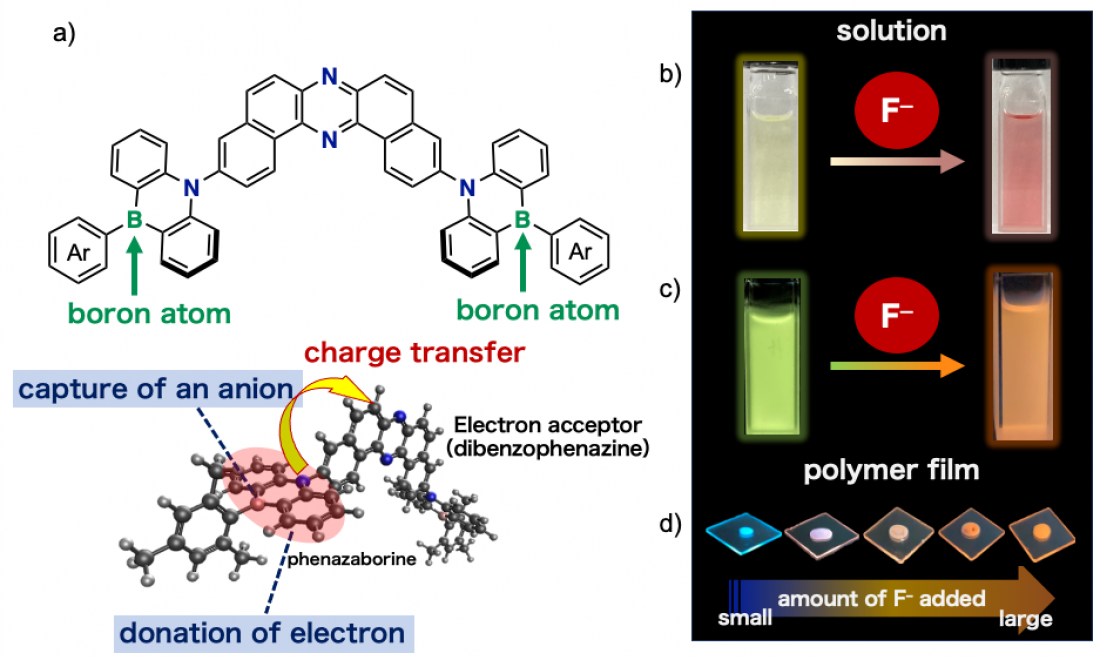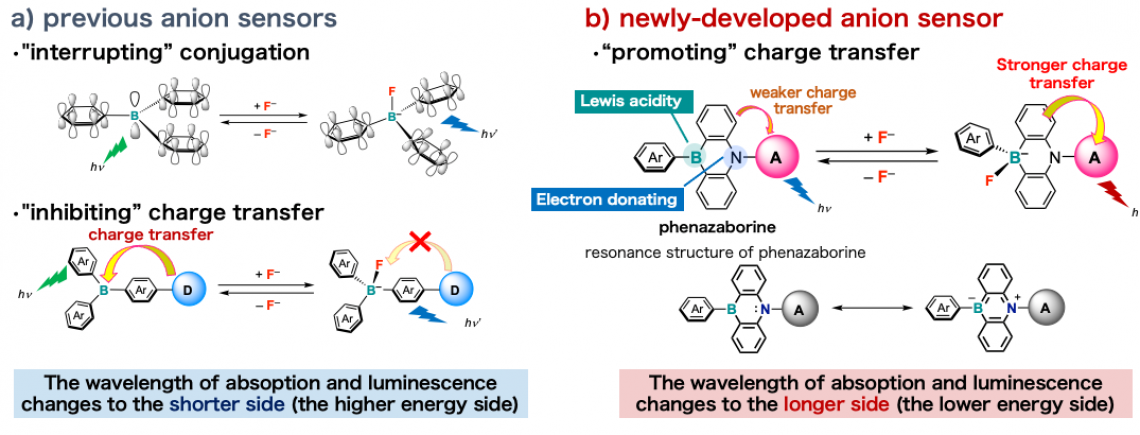The a) chemical structure of the developed sensor molecule, b) color change of the solution when fluoride ions are added, and c) luminescence color change when fluoride ions are added.d) the luminescence of polymer film prepared by adding fluoride ions.
Researchers from Osaka University and collaborating partners have made plastic films that give an uncommon response upon binding to certain anions, which might be useful for many sensing and display technologies
Osaka, Japan – Innovative electronics is one of the many applications of modern plastics. Some recent research efforts have used plastic to improve the color realism of display technologies.
Now, in a study recently published in Angewandte Chemie International Edition, researchers from Osaka University and collaborating partners have developed a borane molecule that exhibits unusual light emission upon binding to fluoride. Incorporating their molecule into common plastic is straightforward, resulting in versatile materials for electronic display and chemical sensing applications.
A class of molecules known as triarylboranes (TABs) has photochemical properties that are useful in optics. For example, upon binding to an anion such as fluoride, disruption of the TAB electronic structure often does two things to the light emission: shortens the wavelength (blue-shift) and reduces the intensity (turn-off response). Lengthening the emission wavelength (red-shift) is nearly unprecedented because corresponding design principles are unavailable. Developing a new class of TAB that exhibits a red-shifted sensing response, and can be easily incorporated into plastic electronics and similar technologies, is the problem the researchers aimed to address.
“Our borane-based sensor exhibits a red-shifted response upon binding to an anion such as fluoride,” explains Nae Aota, lead author of the study. "Our method is based on reducing orbital energy gap of the molecule in the ground state and enhancing charge-transfer in the excited state by reversing the role of TAB from electronic acceptor to donor.”
a) conventional anion sensor molecules and b) anion sensor molecules developed in this study
A highlight of the researchers’ work is facile incorporation of a TAB–fluoride into polystyrene and poly(methyl methacrylate) polymer films. The polymer matrix did not impair the red-shifted light emission. In fact, one film exhibited warm white light—a highly desired property that mimics sunlight. Furthermore, the color of the light emission was finely tunable by simply adjusting the quantity of added fluoride.
“We’re excited by the versatility of our thin films,” says Youhei Takeda, senior author. “We can use the bipolarity of the phenazaboride to prepare plastic films ranging from blue to near-infrared, for displays and ultra-sensitive anion detection.”
This work is an important step forward in electronic display technologies. Furthermore, by tuning the selectivity of the TAB to anion binding (i.e., detecting only one type of anion even in the presence of other potentially competing anions), applications to highly sought sensing technologies will be straightforward.
###
The article, “Anion-responsive colorimetric and fluorometric red-shift in triarylborane derivatives: Dual role of phenazaborine as Lewis acid and electron donor,” was published in Angewandte Chemie International Edition at DOI: https://doi.org/10.1002/anie.202405158
About Osaka University
Osaka University was founded in 1931 as one of the seven imperial universities of Japan and is now one of Japan's leading comprehensive universities with a broad disciplinary spectrum. This strength is coupled with a singular drive for innovation that extends throughout the scientific process, from fundamental research to the creation of applied technology with positive economic impacts. Its commitment to innovation has been recognized in Japan and around the world, being named Japan's most innovative university in 2015 (Reuters 2015 Top 100) and one of the most innovative institutions in the world in 2017 (Innovative Universities and the Nature Index Innovation 2017). Now, Osaka University is leveraging its role as a Designated National University Corporation selected by the Ministry of Education, Culture, Sports, Science and Technology to contribute to innovation for human welfare, sustainable development of society, and social transformation.
Website: https://resou.osaka-u.ac.jp/en




